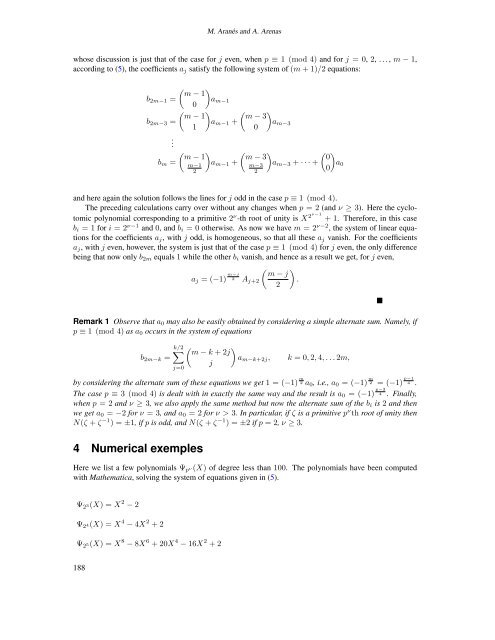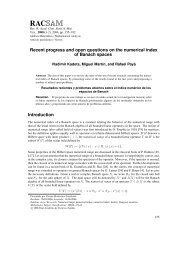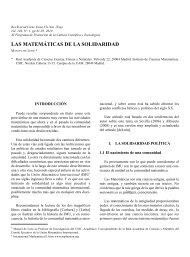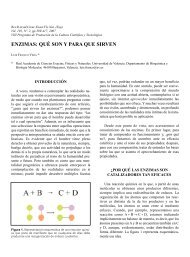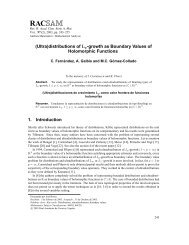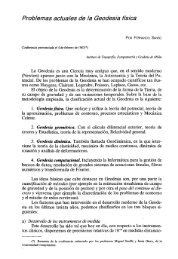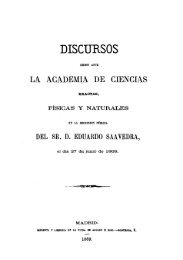On the defining polynomials of maximal real cyclotomic extensions
On the defining polynomials of maximal real cyclotomic extensions
On the defining polynomials of maximal real cyclotomic extensions
Create successful ePaper yourself
Turn your PDF publications into a flip-book with our unique Google optimized e-Paper software.
M. Aranés and A. Arenaswhose discussion is just that <strong>of</strong> <strong>the</strong> case for j even, when p ≡ 1 (mod 4) and for j = 0, 2, . . . , m − 1,according to (5), <strong>the</strong> coefficients a j satisfy <strong>the</strong> following system <strong>of</strong> (m + 1)/2 equations:( ) m − 1b 2m−1 = a m−10( ) ( )m − 1m − 3b 2m−3 = a m−1 + a m−310.b m =( ) m − 1m−1a m−1 +2( )( m − 30m−3a m−3 + · · · + a 020)and here again <strong>the</strong> solution follows <strong>the</strong> lines for j odd in <strong>the</strong> case p ≡ 1 (mod 4).The preceding calculations carry over without any changes when p = 2 (and ν ≥ 3). Here <strong>the</strong> <strong>cyclotomic</strong>polynomial corresponding to a primitive 2 ν -th root <strong>of</strong> unity is X 2ν−1 + 1. Therefore, in this caseb i = 1 for i = 2 ν−1 and 0, and b i = 0 o<strong>the</strong>rwise. As now we have m = 2 ν−2 , <strong>the</strong> system <strong>of</strong> linear equationsfor <strong>the</strong> coefficients a j , with j odd, is homogeneous, so that all <strong>the</strong>se a j vanish. For <strong>the</strong> coefficientsa j , with j even, however, <strong>the</strong> system is just that <strong>of</strong> <strong>the</strong> case p ≡ 1 (mod 4) for j even, <strong>the</strong> only differencebeing that now only b 2m equals 1 while <strong>the</strong> o<strong>the</strong>r b i vanish, and hence as a result we get, for j even,( )a j = (−1) m−j m − j2 A j+2 .2Remark 1 Observe that a 0 may also be easily obtained by considering a simple alternate sum. Namely, ifp ≡ 1 (mod 4) as a 0 occurs in <strong>the</strong> system <strong>of</strong> equationsk/2∑( )m − k + 2jb 2m−k =a m−k+2j , k = 0, 2, 4, . . . 2m,jj=0by considering <strong>the</strong> alternate sum <strong>of</strong> <strong>the</strong>se equations we get 1 = (−1) m 2 a 0 , i.e., a 0 = (−1) m 2 = (−1) p−14 .The case p ≡ 3 (mod 4) is dealt with in exactly <strong>the</strong> same way and <strong>the</strong> result is a 0 = (−1) p−34 . Finally,when p = 2 and ν ≥ 3, we also apply <strong>the</strong> same method but now <strong>the</strong> alternate sum <strong>of</strong> <strong>the</strong> b i is 2 and <strong>the</strong>nwe get a 0 = −2 for ν = 3, and a 0 = 2 for ν > 3. In particular, if ζ is a primitive p ν th root <strong>of</strong> unity <strong>the</strong>nN(ζ + ζ −1 ) = ±1, if p is odd, and N(ζ + ζ −1 ) = ±2 if p = 2, ν ≥ 3.4 Numerical exemplesHere we list a few <strong>polynomials</strong> Ψ p ν (X) <strong>of</strong> degree less than 100. The <strong>polynomials</strong> have been computedwith Ma<strong>the</strong>matica, solving <strong>the</strong> system <strong>of</strong> equations given in (5).Ψ 2 3(X) = X 2 − 2Ψ 2 4(X) = X 4 − 4X 2 + 2Ψ 2 5(X) = X 8 − 8X 6 + 20X 4 − 16X 2 + 2188


